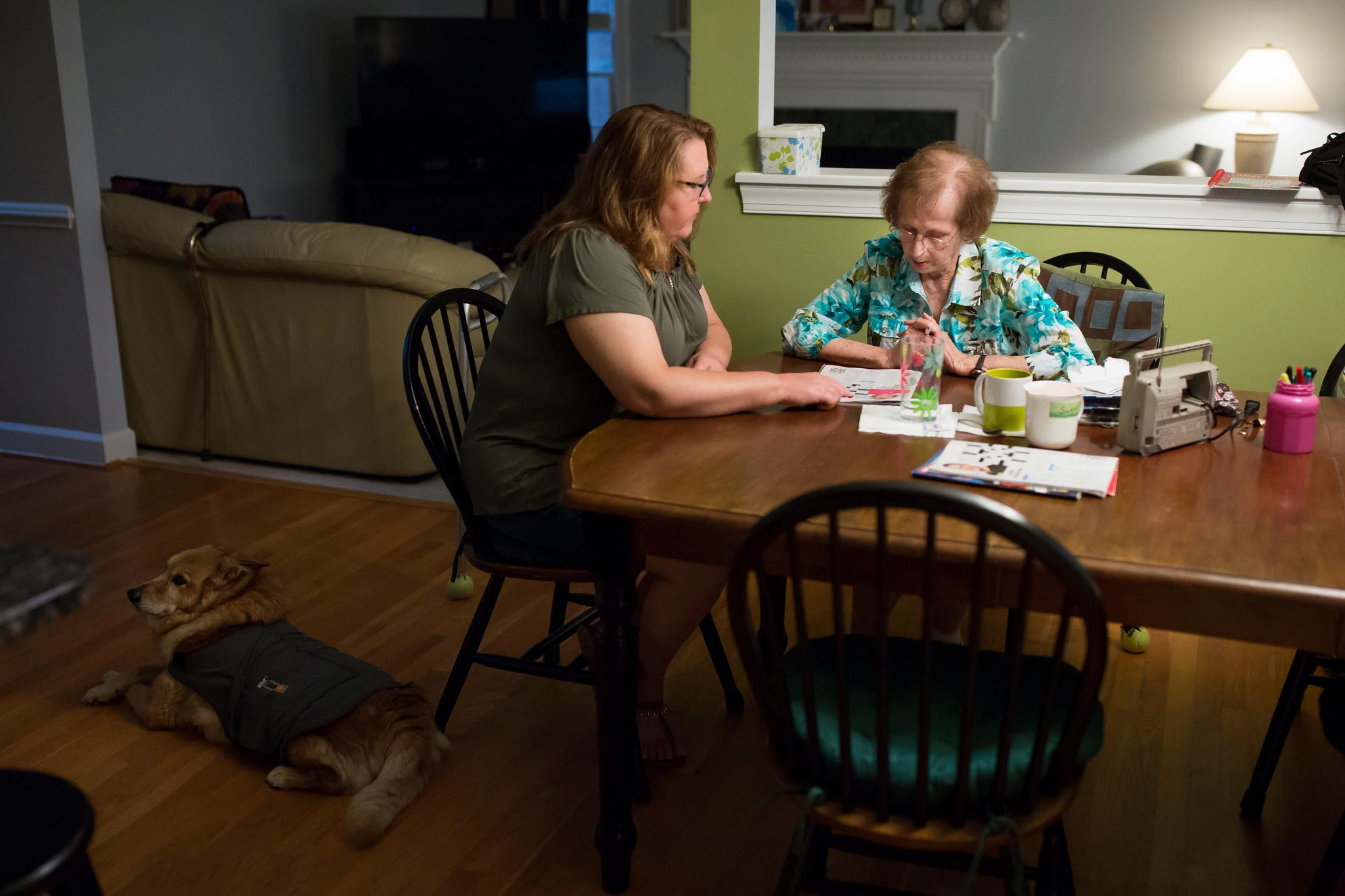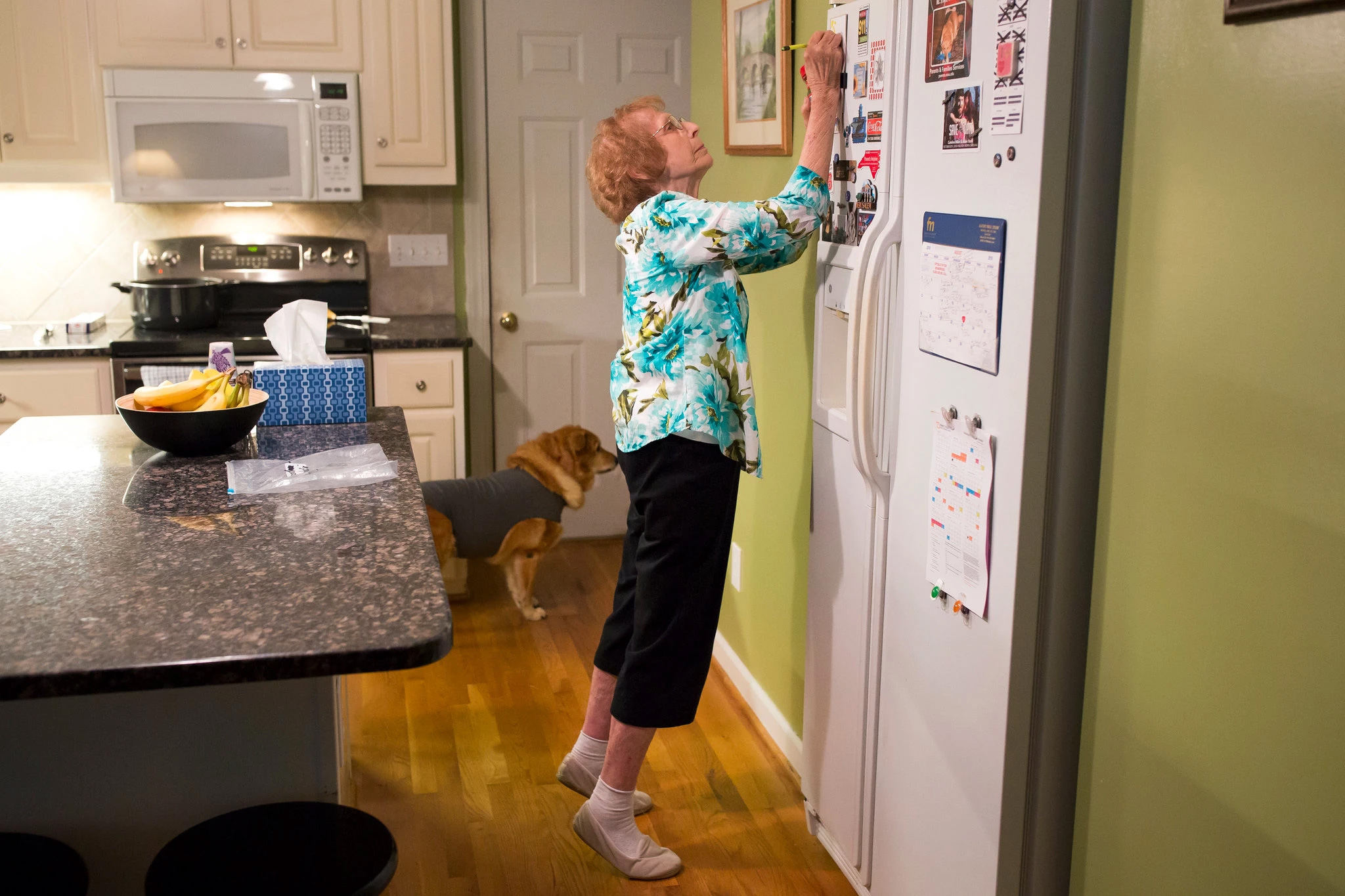The Illness Is Bad Enough. The Hospital May Be Even Worse.
By Paula Span
Published: August 3, 2018
The elderly are particularly vulnerable to “post-hospital syndrome,” some experts believe, and that may be why so many patients return.

Bernadine Lewandowski, left, makes spaghetti sauce with her daughter, Dona Jones. Ms. Lewandowski lived independently until recent hospitalizations.
When she moved from Michigan to be near her daughter in Cary, N.C., Bernadine Lewandowski insisted on renting an apartment five minutes away.
Her daughter, Dona Jones, would have welcomed her mother into her own home, but “she’s always been very independent,” Ms. Jones said.
Like most people in their 80s, Ms. Lewandowski contended with several chronic illnesses and took medication for osteoporosis, heart failure and pulmonary disease. Increasingly forgetful, she had been diagnosed with mild cognitive impairment. She used a cane for support as she walked around her apartment complex.
Still, “she was trucking along just fine,” said her geriatrician, Dr. Maureen Dale. “Minor health issues here and there, but she was taking good care of herself.”
But last September, Ms. Lewandowski entered a hospital after a compression fracture of her vertebra caused pain too intense to be managed at home. Over four days, she used nasal oxygen to help her breathe and received intravenous morphine for pain relief, later graduating to oxycodone tablets.
Even after her discharge, the stress and disruptions of hospitalization — interrupted sleep, weight loss, mild delirium, deconditioning caused by days in bed — left her disoriented and weakened, a vulnerable state some researchers call “post-hospital syndrome.”
They believe it underlies the stubbornly high rate of hospital readmissions among older patients. In 2016, about 18 percent of discharged Medicare beneficiaries returned to the hospital within 30 days, according to the federal Centers for Medicare and Medicaid Services.
Ms. Lewandowski, for example, was back within three weeks. She had developed a pulmonary embolism, a blood clot in her lungs, probably resulting from inactivity. The clot exacerbated her heart failure, causing fluid buildup in her lungs and increased swelling in her legs. She also suffered another compression fracture.
“These hospitalizations can lead to big life changes,” Dr. Dale said. Having grown too frail to live alone, Ms. Lewandowski, now 84, moved in with her daughter.

Ms. Lewandowski and Ms. Jones collaborating on a crossword. Ms. Lewandowski’s condition has improved, but she is too frail to live alone.
Dr. Harlan Krumholz, a cardiologist at Yale University, coined the phrase “post-hospital syndrome” in a New England Journal of Medicine article in 2013.
As Medicare began penalizing hospitals for 30-day readmissions under the Affordable Care Act, he looked at the national data and noticed that most readmissions involved conditions seemingly unrelated to the initial diagnoses.
Patients came in with heart failure or pneumonia, were treated and discharged, then returned with internal bleeding or injuries from a fall.
“Our general approach in a hospital is, all hands on deck to deal with the problem people come in with,” Dr. Krumholz said. “All the other discomforts are seen as a minor inconvenience.”
He has argued instead that discharge marks the start of a 60- to 90-day period of increased vulnerability to a range of other health problems, stemming from the stress of hospitalization itself.
“This is more than inconvenience,” he said. “This is toxic. It’s detrimental to people’s recovery.”
Any hospital patient, or hovering family member, knows those stresses: Disrupted sleep, as staff draw blood and take vital signs at 4 a.m. A distorted sense of day and night. Unappetizing meals often served at inopportune times.
Reduced muscle mass and poor balance following even a few days in bed. New prescriptions with unpredictable consequences. Shared rooms. Delirium. Pain.
“It affects your hormones, your metabolism, your immune system,” Dr. Krumholz said. “All these things have widespread effects,” leaving people depleted and less able to stave off other health threats.
The ripple effects vary considerably.
Researchers at Yale followed discharged Medicare patients after hospitalizations for heart failure, heart attacks and pneumonia.
Readmissions for gastrointestinal bleeding and anemia, they found, peaked four to 10 days after discharge. The risk of trauma from falls or other accidents, on the other hand, remained elevated for three to five weeks.
While post-hospital syndrome remains a hypothesis for now, research on several fronts may help establish its validity.
Donald Edmondson, a behavioral medicine researcher at Columbia University Medical Center, has pointed out links between the stress levels that heart attack victims report and their likelihood of readmission.
In a meta-analysis, he and his colleagues found that 12 to 16 percent of heart attack patients, most of them older adults, actually develop post-traumatic stress syndrome.
As Dr. Edmondson acknowledged, people experiencing heart attacks have multiple sources of stress, from fear of death to financial worries. But he and his colleagues also have measured the impact of the hospital environment itself. They compared patients (average age: 63) who came to the NewYork-Presbyterian Hospital emergency room when it was crowded and chaotic (median time in a crowded ER: 11 hours) to those who arrived when it was calmer.
“The more crowded it is when you come in, the more PTSD symptoms you’ll have a month later,” he concluded.
Now the Columbia researchers are following 1,000 E.R. patients with heart attacks, tracking their weight and stress levels and giving each a wearable device to measure physical activity and sleep. The results may help substantiate the effects of post-hospital syndrome.
“We’ve gotten better and better at treating disorders, but we haven’t gotten to the point where we avoid some of the collateral damage to the patient,” Dr. Edmondson said.
Making hospitals less destabilizing, more conducive to healing, seems an achievable goal. Hospitals do it for children, Dr. Krumholz has pointed out.
They could enable older patients, too, to wear their own clothes, get out of bed for walks (even with IV poles), eat enough to maintain their weight. They could assess how many lab tests patients actually need, and whether blood needs to be drawn before dawn.
“We should never wake a sleeping patient unless there’s a compelling reason, and that reason shouldn’t be our own convenience,” Dr. Krumholz said.
But while we’re waiting for hospitals to adopt such policies, we could try a D.I.Y. approach.

Ms. Lewandowski adding items to a grocery list. She can climb the stairs again, with help, and enjoys regular hair salon visits.
Families can bring in favorite foods and help their relatives eat. They can ensure that patients have their hearing aids, dentures, eyeglasses, and walkers or canes to help them stay oriented and mobile.
With a physician’s O.K., they can accompany relatives on short strolls down the corridor to ward off deconditioning, and ask about curtailing wee-hour tests and readings.
“It’s unfair to put families in this position,” Dr. Krumholz said. “It should come from the institution.” But cultural change takes time.
Some hospitals already offer less stressful environments for older patients, including specialized geriatric emergency rooms.
Among those moving in that direction is the University of North Carolina Hospitals Hillsborough Campus, where Bernadine Lewandowski had a private room, as all its geriatrics patients do. She was helped into a chair every day and encouraged to use a walker to reach her bathroom.
The aftereffects proved profound, nonetheless. Already thin, she lost 15 pounds over two months. After her second hospitalization, she began wandering at night, apparently because of a new pain medication, and fell twice in two days. In April, she developed pneumonia, necessitating a third hospital stay.
She’s doing better now, her daughter said. After physical therapy, Ms. Lewandowski can climb the stairs, with someone at her elbow, to her second-floor room. Her weight has stabilized. She enjoys spending time with her family and visiting the hair salon every other week.
But, Ms. Jones said, “we were hoping she’d be with us for a short period and then return to her apartment.” And that never happened.


